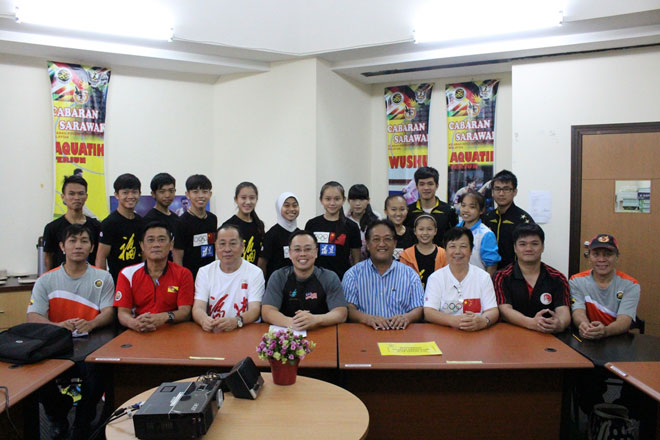Wushu athletes told not to ‘trip’ and waste years of sacrifices

Participants of the clinic posing with Erik Tan (fifth right), Ting (fourth right), MSNS coordinator for wushu Thomas Chia (second left), motivator for Sarawak Contingent for Sukma XVIII from Sarawak Sports Corporation, Clarence Loong (right) and the coaches.
KUCHING: State wushu athletes must beware of injuries at this crucial time when the calendar is ticking down to only three months to go before Sukma XVIII, with fatigue diagnosed as the biggest enemy for all athletes at large.
“I know you have trained very hard for Sukma XVIII and it will be a pity when all the hard work and months or even years of training, sacrifices go to waste because of an injury.
“Injuries happen when an athlete is tired, having loss of concentration or focus, muscle imbalance, overuse, insufficient recovery and incorrect techniques,” National Sports Institute (NSI) strength and conditioning coach Erik Tan told wushu athletes and coaches at a strength and conditioning clinic at ISN Sarawak Satellite Centre yesterday.
The 12 athletes are from the state wushu squad for Sukma XVIII while the coaches are Yoong Thong Foong, Lau Hui Wei, Wong Hua Yiing, Lyde Lait and William Bong from the Wushu Federation of Sarawak (WFS).
According to Erik, fatigue is a critical factor in athletic injuries. When athletes are tired, their bodies cannot respond to athletic demands and cannot avoid acute injuries.
“The common injuries in wushu are ankle, knee and lower back,” said Erik.
He added that strength and conditioning are important to athletes to meet the demands of training and competition, injury prevention, health and wellness, and self confidence.
“There is a need to find out an athlete’s injury and status so that it can be managed properly. Basically, there are two types of injuries, acute or chronic. Most injuries happen during training when the athlete is tired while some happen outside of training like accidents.
“If an athlete is injured, he/she must be rested, seek treatment, followed by physiotherapy and rehabilitation,” he said.
Erik said athletes can train the non-injured parts of body when he/she is injured but strongly advised against training through an injury because it would aggravate it further. “Small injuries must be attended to immediately otherwise they might turn into bigger injury over time.”
He stressed on the importance of being able to differentiate pain from muscle after training or injury.
To prevent injury, Eric said athletes must warm up thoroughly before commencing their training, strengthening muscles around the joint, do proprioception training, improve overall fitness and ensuring adequate recovery after high intensity training.
The recovery modalities include active recovery (slow jog, cycling etc), ample sleep, stretching, foam rolling, massage, hot/cold contrast bath and cold water immersion.
